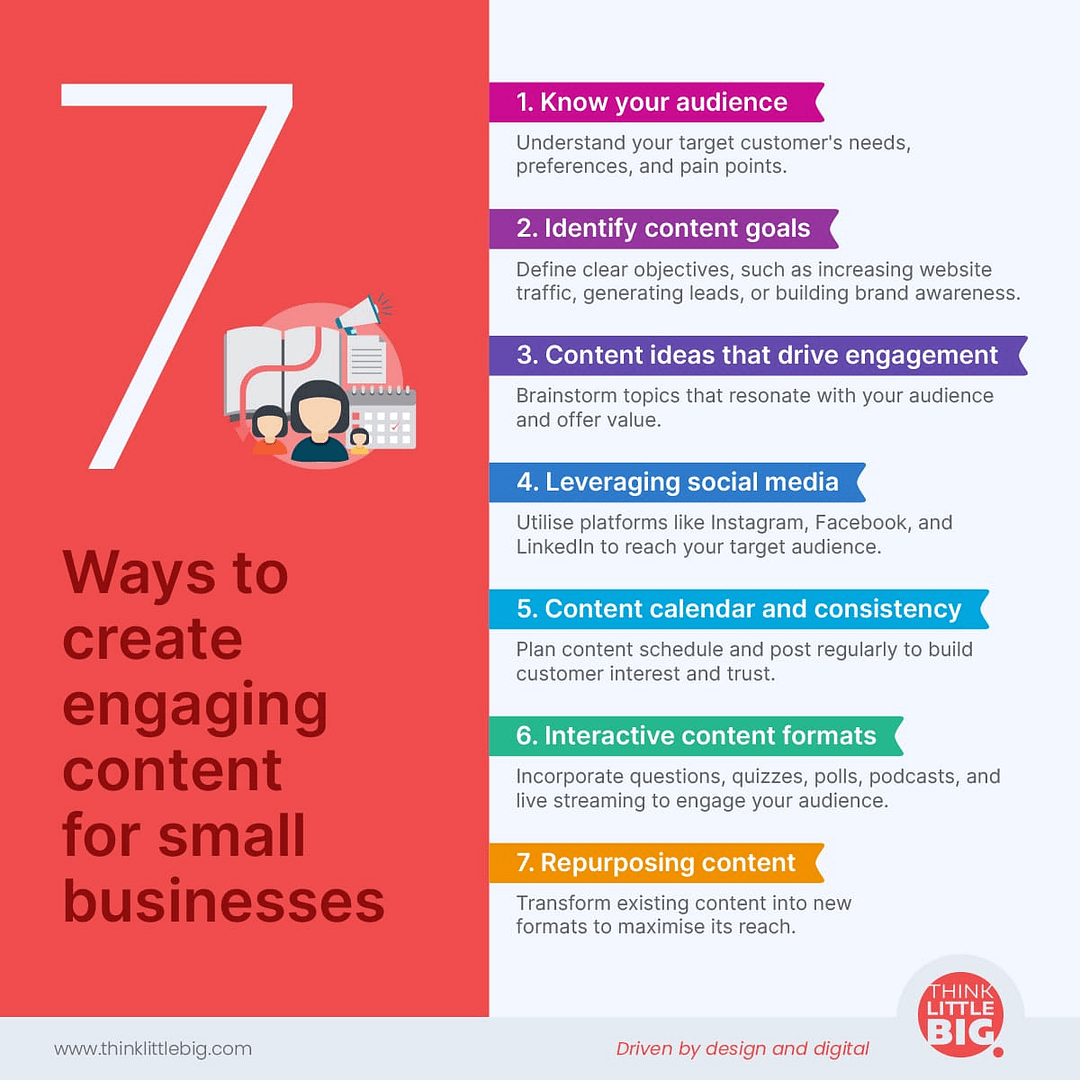In today’s ever-evolving digital landscape, creating engaging content is no longer a luxury for small businesses but a necessity. To stand out and connect with potential customers, small businesses must master the art of content marketing.
What comes to mind when you think of ‘content’ as a small business owner? You have probably heard that the key to success is to reach your target audience online by creating engaging content that showcases your value proposition. However, writing content that truly resonates with your target audience goes beyond mere creation; it is about building a connection.
Then, what is the point of writing content? Well, unless you just like writing, then most businesses create engaging content with the objective of generating leads. The process is straightforward. This blog will describe how to create engaging content for small businesses. Let’s get started.

1. Know your audience
Knowing who you’re trying to reach is the cornerstone of creating engaging and informative content. What are points of interest and pain points? What is your business trying to deliver to your target audience? These insights will act as a foundation for creating engaging content and make it more effective.
Defining your target audience is the first step to creating engaging content. You need to consider the type of customers who will be interested in your product or service. Understand their needs, the questions they might ask, how they want to use your product and other aspects that will distinguish them. In this way, you can create your ‘customer profile’, which you can use to drive your content strategy around addressing their needs.
It is always a good idea to check how your competitors leverage content strategy. This will help you differentiate your brand and stand out, connecting with your audience. Once you have a clear picture of your target audience, you can tailor content that resonates with them.
2. Identifying content goals
Before you start writing content, creating a content strategy and having a goal to accomplish is crucial. What are you trying to achieve with your content? Setting a proper content goal helps you measure its success and ensure it is aligned with your business goals.
Setting SMART (Specific, Measurable, Achievable, Relevant, and Time-bound) goals for your content strategy is the cornerstone. Identify what you are trying to achieve with your content; for example, is it to generate leads, build brand awareness, or increase organic traffic for your website.
To help with the structure of your content, you might set REAL content standards, which means:
- Relevant to your customers
- Engaging and interesting
- Authentic to your brand values, customers
- Likeable by your customers
It will help you stick to a strategy where effectiveness can be measured based on your customer needs and business goals.
3. Content ideas that drive engagement
Content is king, and creating engaging and informative content is essential for delivering value propositions to customers. While you can make hundreds of different forms of content, it might not yield results.
It is important to identify the content formats your target customers are interested in. Depending on the customer’s needs and your content marketing goals, you need to specify different content formats that resonate with your target audiences.
For that, you can brainstorm different content ideas based on your audience’s pain points and interests. Deliver the content in a way that adds value to customers. Invest time and resources into creating informative, well-crafted, search-engine-optimised, and visually appealing content that engages visitors and converts them into potential customers.
Experimenting with various content formats, such as infographics, blog posts, eBooks, guides, hosting webinars, etc., is critical to creating engaging content. See which format resonates best with your audience.
For instance, sharing user-generated content such as customer testimonials and stories is a powerful tool to build brand credibility and trust. Creating engaging and informative content, like tutorials, how-to guides, etc., is an excellent way to attract customer attention and position your brand as a thought leader.
4. Leveraging social media
Social media platforms are not just tools for marketing but also powerful ways to build a community. According to Forbes, more than 52% of businesses’ content marketing budget is spent on social media and community building. By selecting the platforms that align with your customers, you can create a sense of connection and belonging, making your audience feel part of a more extensive network.
After you have sorted your preferred social media platforms, it is time to create social media campaigns and consistently post about your products or services. You can create posts that encourage your customers to participate in your brand.
Customer engagement works both ways. If your customers send messages or respond to your posts, you must react promptly as a brand. However, if you want to target a wider audience, you can leverage the benefits of paid social media advertising, which is more effective in generating potential leads.
Another way to leverage your social media strategy is to create shareable content so that whoever visits your post is bound to share the content. In this way, you can increase your reach while fulfilling customer demands.
5. Content calendar and consistency
Now that you have selected your preferred social media platforms and content formats, have you considered documenting your strategy? If you have a clear objective such as creating brand awareness or generating leads, then you should create a plan and make a content calendar.
A content calendar is essential for a marketer to organise and plan the content creation process. It can help you plan the ‘story’, ensure you cover the different points and aspects you want to convey and bring consistency to the content you create, an important content marketing tip for those new to content creation.
With a content calendar, you can include titles with scheduling dates and authors and visualise your content production pipeline. Measuring content effectiveness is also essential so that you can make necessary changes in your content marketing strategy to align with your customer needs.
6. Interactive content formats
There has been a significant rise in businesses integrating interactive content into their marketing plans, with the percentage almost doubling within a year. In 2023, 36.1% of companies utilised interactive content such as calculators and quizzes; in 2024 this figure increased to 62.3%.
Immersive and interactive content is one of the best examples of engaging content. As a small business owner, you should focus on interactive content on your website and social media platforms. Interactive content has the power to convert passive readers into active customers.
Creating posts like quizzes, polls, contests, giveaways, webinars, live streams, etc., will engage your followers to participate and allow you to interact with them. It is one of the most essential content strategies for small business owners and one which will yield results in multiple facets if implemented correctly.
The benefits of creating interactive content are not limited to customer engagement only. You can also get to know your customers better, their interests, preferences, expectations, and suggestions regarding your product. This way, you can personalise your brand and create products and services to meet your target customer’s needs.
7. Repurposing content
Apart from creating engaging content on your website, you should also focus on repurposing your old content. A small business needs to stay relevant and updated in this rapidly changing business environment.
Repurposing old content can also be an ongoing process in which you update it and transform it into a new format. For instance, you can create infographics or a social media post from blog posts.
You also have the option to update older content with newer information, add images, remove broken links, and replace existing CTA with your current product offerings.
If you have an eBook, you can re-release it as an audiobook or into smaller blog posts. Else you can convert a guide into a video tutorial or vice versa. This way, you can create engaging content to captivate your customers, build brand loyalty, and drive business growth.
Final thoughts
More than 54.5% of small businesses intend to increase their investment in content marketing strategies in 2024 compared to the previous year. Hence, it is time for small businesses to improve their content marketing efforts and build a foundation for organically attracting customers.
Small businesses can build customer loyalty to drive conversions by clearly understanding their target audience, setting content marketing goals, and consistently creating engaging and informative content.
While this process demands time and consistent effort, the long-term benefits are significant. To measure the performance of your current content marketing strategy, you need to focus on implementing data-driven approaches and periodically refining the strategies.
If you feel overwhelmed in this process, you can always seek help from a reputed content marketing agency for small businesses. At Think Little Big, we always focus on business needs to create content marketing strategies that yield results. Book a consultation to learn more about how we work with small businesses.



